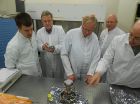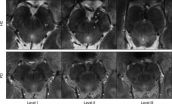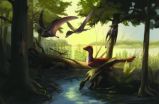HOUSTON, TX, March 05, 2014 (Press-News.org) Keeping a spare on hand simply makes sense. Just as drivers keep spare tires on hand to replace a flat or blowout, NASA routinely maintains "spares," too. These flight hardware backups allow NASA to seamlessly continue work in the unlikely event something goes down for a repair. When projects end, these handy spares can sometimes find second lives in new areas for use.
Researchers at NASA's Marshall Space Flight Center in Huntsville, Ala., developed a sophisticated piece of flight hardware called a Lightning Imaging Sensor (LIS) to detect and locate lightning over the tropical region of the globe. Launched into space in 1997 as part of NASA's Tropical Rainfall Measuring Mission (TRMM), the sensor undertook a three-year baseline mission, delivering data used to improve weather forecasts. It continues to operate successfully aboard the TRMM satellite today.
The team that created this hardware in the mid-1990s built a spare -- and now that second unit is stepping up to contribute, as well. The sensor is scheduled to launch on a Space Exploration Technologies (SpaceX) rocket to the International Space Station in February 2016. Once mounted to the station, it will serve a two-year baseline mission as part of a U.S. Department of Defense (DoD) Space Test Program (STP)-H5 science and technology development payload. STP-H5 is integrated and flown under the management and direction of the DoD's STP.
NASA selected the LIS spare hardware to fly to the space station in order to take advantage of the orbiting laboratory's high inclination. This vantage point gives the sensor the ability to "look" farther towards Earth's poles than the original LIS can aboard the TRMM satellite. Once installed, the sensor will monitor global lightning for Earth science studies, provide cross-sensor calibration and validation with other space-borne instruments, and ground-based lightning networks. LIS will also supply real-time lightning data over data-sparse regions, such as oceans, to support operational weather forecasting and warning.
"Only LIS globally detects all in-cloud and cloud-to-ground lightning -- what we call total lightning -- during both day and night," said Richard Blakeslee, LIS project scientist at Marshall. "As previously demonstrated by the TRMM mission, better understanding lightning and its connections to weather and related phenomena can provide unique and affordable gap-filling information to a variety of science disciplines including weather, climate, atmospheric chemistry and lightning physics."
LIS measures the amount, rate and radiant energy of global lightning, providing storm-scale resolution, millisecond timing, and high, uniform-detection efficiency -- and it does this without land-ocean bias.
The sensor consists of an optical imager enhanced to locate and detect lightning from thunderstorms within its 400-by-400-mile field-of-view on the Earth's surface. The station travels more than 17,000 mph as it orbits our planet, allowing the LIS to observe a point on the Earth, or a cloud, for almost 90 seconds as it passes overhead. Despite this brief viewing duration, it is long enough to estimate the lightning-flashing rate of most storms.
Since more than 70 percent of lightning occurs during the day, daytime detection drove the technical design of the LIS. From space, lightning appears like a pool of light on the top of a thundercloud. During the day, sunlight reflected from the cloud tops completely masks the lightning signal, making it difficult to detect. However, LIS creates a solution by applying special techniques that take advantage of the differences in the behavior and physical characteristics of lightning and sunlight signals. These allow LIS to extract the strikes from bright background illumination.
As a final step in processing, a real-time event processor inside the LIS electronics unit removes the remaining background signal, enabling the system to detect the lightning signatures and achieve 90-percent detection efficiency.
Once the sensor is installed on the space station, the LIS team will operate it remotely. They will then assess the data it produces and disseminate it to forecasters and researchers from the Global Hydrology Resource Center, one of NASA's Earth science data centers.
This instrument also can help our lives on Earth in many ways. The LIS science team has received strong endorsements from several national and international government agencies and university science organizations. These include the National Oceanic and Atmospheric Administration (NOAA), European Space Agency (ESA), Japan Aerospace Exploration Agency (JAXA) and the Geostationary Operational Environmental Satellite R- Series Program (GOES-R). Operational users, such as NOAA's National Weather Service (NWS), Aviation Weather Center (AWC), Ocean Prediction Center (OPC) and Pacific Region will be interested in the data for their operational weather warning, forecasting and even validation applications. For other users, their science and application investigations will be improved and will benefit from the new lightning observations provided by LIS.
From a research standpoint, LIS data could be very useful to the Federal Aviation Administration (FAA). Randy Bass, a member of the FAA's Aviation Weather Research Team, said the information obtained could help them with validation activities of several oceanic convection ensemble model products they're developing, either in real-time or archive mode.
"It could also be used for validation of detection of convection from other ground- and space-based sensors we will be using at the time," said Bass. "Any data we can use for 'ground truth' over oceanic areas will be extremely helpful in development of better observing and forecasting products used for offshore aviation, especially as we expand our coverage throughout the Atlantic and Pacific oceans."
The end result would be better short-term forecasts of thunderstorms over offshore areas, giving pilots and air traffic controllers a better ability to reroute planes around hazards such as turbulence and lightning strikes. Bass said that while pilots have weather radar aboard, they can only see limited areas ahead of them. The FAA wants to improve their capability and give controllers the opportunity to see the weather activity too, which they don't have right now.
As lightning flashes above our heads, there's a lot to be learned about this electrical phenomena -- and the LIS team aims to find the answers to a lot of those questions.
"Measuring lightning is important for knowledge about the weather and also operationally important for aviation safety. By adding an instrument on space station, we can add observations from higher latitudes covering the 48 contiguous states," said International Space Station Chief Scientist Julie Robinson, Ph.D. "This is a prime example of science on the International Space Station benefiting our nation."
By Janet Anderson
NASA's Marshall Space Flight Center
By Jessica Eagan
International Space Station Program Science Office
NASA's Marshall Space Flight Center
Space Station Sensor to Capture 'Striking' Lightning Data
Researchers at NASA's Marshall Space Flight Center in Huntsville, Ala., developed a sophisticated piece of flight hardware called a Lightning Imaging Sensor to detect and locate lightning over the tropical region of the globe.
2014-03-05
ELSE PRESS RELEASES FROM THIS DATE:
Scarring - Top Surgeons and Dermatologists Agree That Post-Surgery Patients Necessitate Custom Scar Management Plans That Includes bioCorneum
2014-03-05
bioCorneum (www.biocorneum.com) the easy to use silicone scar gel with SPF 30, cleared by the FDA, has an innovative new website that will provide education on scar management for patients, doctors, and other medical professionals. The new site launches March 12th 2014 and is easy to access on all devices.
About The New Website - Designed by Blender - www.blendercompany.com
- Scar management essentials
- Current news and trends on scarring
- Where bioCorneum is available for consumers
--FAQ
--Info for doctors and their offices on carrying bioCorneum
--411 ...
uPushit Launches as the First Social Challenge Network
2014-03-05
De'Lamar Technologies Corporation, a startup Internet technology company, is proud to announce the launch of uPushit.com. Built on the idea of engagement and rewards, uPushit.com offers users the ability to share thoughts, ideas and personal experiences, but branches much further than any other social network to date - giving users the ability to earn revenue by building income through indulging in cash tournaments and engaging in ground-breaking auctions.
uPushit.com was built on the idea of four main principles; have fun, share, socialize and capitalize, while you ...
Ultra-high-field MRI may allow earlier diagnosis of Parkinson's disease
2014-03-05
OAK BROOK, Ill. – New research shows that ultra-high-field magnetic resonance imaging (MRI) provides detailed views of a brain area implicated in Parkinson's disease, possibly leading to earlier detection of a condition that affects millions worldwide. The results of this research are published online in the journal Radiology.
Parkinson's disease is a chronic, progressive disease characterized by shaking, stiffness, and impaired balance and coordination. With no radiologic techniques available to aid in diagnosis, clinicians have had to rely on medical history and neurological ...
3D scans map widespread fish disease
2014-03-05
AQUATIC ENVIRONMENT Seventy-five per cent of antibiotics in Danish fish farms is used to treat fish with enteric redmouth disease. With the help of 3D scans, researchers at the University of Copenhagen have mapped how the fish are infected with the bacterium. The findings were recently published in the scientific publication PLOS ONE.
Fascinating 3D images of rainbow trout give researchers a crystal clear picture of how the bacterium causing enteric redmouth disease infects fish.
"The new scans show us that the fish are infected through their ultra-thin gills," explains ...
Muscle-controlling neurons know when they mess up, according to Penn research
2014-03-05
Whether it is playing a piano sonata or acing a tennis serve, the brain needs to orchestrate precise, coordinated control over the body's many muscles. Moreover, there needs to be some kind of feedback from the senses should any of those movements go wrong. Neurons that coordinate those movements, known as Purkinje cells, and ones that provide feedback when there is an error or unexpected sensation, known as climbing fibers, work in close concert to fine-tune motor control.
A team of researchers from the University of Pennsylvania and Princeton University has now begun ...
Motion-sensing cells in the eye let the brain 'know' about directional changes
2014-03-05
How do we "know" from the movements of speeding car in our field of view if it's coming straight toward us or more likely to move to the right or left?
Scientists have long known that our perceptions of the outside world are processed in our cortex, the six-layered structure in the outer part of our brains. But how much of that processing actually happens in cortex? Do the eyes tell the brain a lot or a little about the content of the outside world and the objects moving within it?
In a detailed study of the neurons linking the eyes and brains of mice, biologists at UC ...
New approach to breast reconstruction surgery reduces opioid painkiller use
2014-03-05
New York — March 3, 2014 — A new approach to breast reconstruction surgery aimed at helping patients' bodies get back to normal more quickly cut their postoperative opioid painkiller use in half and meant a day less in the hospital on average, a Mayo Clinic study found. The method includes new pain control techniques, preventive anti-nausea treatment and getting women eating and walking soon after free flap breast reconstruction surgery. It has proved so effective, it is now being used across plastic surgery at Mayo Clinic. The findings were being presented at the Plastic ...
Study: Greater music dynamics in shoebox-shaped concert halls
2014-03-05
Therefore, such a concert hall shape affects perceived dynamic range even though rooms itself amplify all passages the same amount.
"Dynamic expression is an inseparable part of music. For this reason, a concert hall's ability to transmit the orchestra's played dynamics is one of the most important criteria of good acoustics. Our research is the first that explains how halls influence perception of dynamic expression," Dr. Jukka Pätynen says.
The importance of early lateral reflections to good concert hall acoustics has been known for decades. Earlier, they were believed ...
Prequel outshines the original: Exceptional fossils of 160 million year old doahugou biota
2014-03-05
Over the last two decades, huge numbers of fossils have been collected from the western Liaoning Province and adjacent parts of northeastern China, including exceptionally preserved feathered dinosaurs, early birds, and mammals. Most of these specimens are from the Cretaceous Period, including the famous Jehol Biota. However, in recent years many fossils have emerged from sites that are 30 million years earlier, from the Middle-Upper Jurassic Period, providing an exceptional window on life approximately 160 million years ago. A new paper published in latest issue of the ...
What bat brains might tell us about human brains
2014-03-05
WASHINGTON — Could a new finding in bats help unlock a mystery about the human brain? Likely so, say researchers at Georgetown University Medical Center who have shown that a small region within the amygdala, an almond-shaped structure in the brains of all mammals, is responsible for producing emotional calls and sounds. They say this discovery might be key to locating a similar center in human brains.
Localizing and manipulating this center in the human brain may provide a way to treat malfunctions in emotional responses, resulting, for example, in pathological aggression, ...
LAST 30 PRESS RELEASES:
Weaving secondary battery electrodes with fibers and tying them like ropes for both durability and performance
Using social media may impair children’s attention
Science briefing: An update on GLP-1 drugs for obesity
Lower doses of immunotherapy for skin cancer give better results
Why didn’t the senior citizen cross the road? Slower crossings may help people with reduced mobility
ASH 2025: Study suggests that a virtual program focusing on diet and exercise can help reduce side effects of lymphoma treatment
A sound defense: Noisy pupae puff away potential predators
Azacitidine–venetoclax combination outperforms standard care in acute myeloid leukemia patients eligible for intensive chemotherapy
Adding epcoritamab to standard second-line therapy improves follicular lymphoma outcomes
New findings support a chemo-free approach for treating Ph+ ALL
Non-covalent btki pirtobrutinib shows promise as frontline therapy for CLL/SLL
University of Cincinnati experts present research at annual hematology event
ASH 2025: Antibody therapy eradicates traces of multiple myeloma in preliminary trial
ASH 2025: AI uncovers how DNA architecture failures trigger blood cancer
ASH 2025: New study shows that patients can safely receive stem cell transplants from mismatched, unrelated donors
Protective regimen allows successful stem cell transplant even without close genetic match between donor and recipient
Continuous and fixed-duration treatments result in similar outcomes for CLL
Measurable residual disease shows strong potential as an early indicator of survival in patients with acute myeloid leukemia
Chemotherapy and radiation are comparable as pre-transplant conditioning for patients with b-acute lymphoblastic leukemia who have no measurable residual disease
Roughly one-third of families with children being treated for leukemia struggle to pay living expenses
Quality improvement project results in increased screening and treatment for iron deficiency in pregnancy
IV iron improves survival, increases hemoglobin in hospitalized patients with iron-deficiency anemia and an acute infection
Black patients with acute myeloid leukemia are younger at diagnosis and experience poorer survival outcomes than White patients
Emergency departments fall short on delivering timely treatment for sickle cell pain
Study shows no clear evidence of harm from hydroxyurea use during pregnancy
Long-term outlook is positive for most after hematopoietic cell transplant for sickle cell disease
Study offers real-world data on commercial implementation of gene therapies for sickle cell disease and beta thalassemia
Early results suggest exa-cel gene therapy works well in children
NTIDE: Disability employment holds steady after data hiatus
Social lives of viruses affect antiviral resistance
[Press-News.org] Space Station Sensor to Capture 'Striking' Lightning DataResearchers at NASA's Marshall Space Flight Center in Huntsville, Ala., developed a sophisticated piece of flight hardware called a Lightning Imaging Sensor to detect and locate lightning over the tropical region of the globe.






